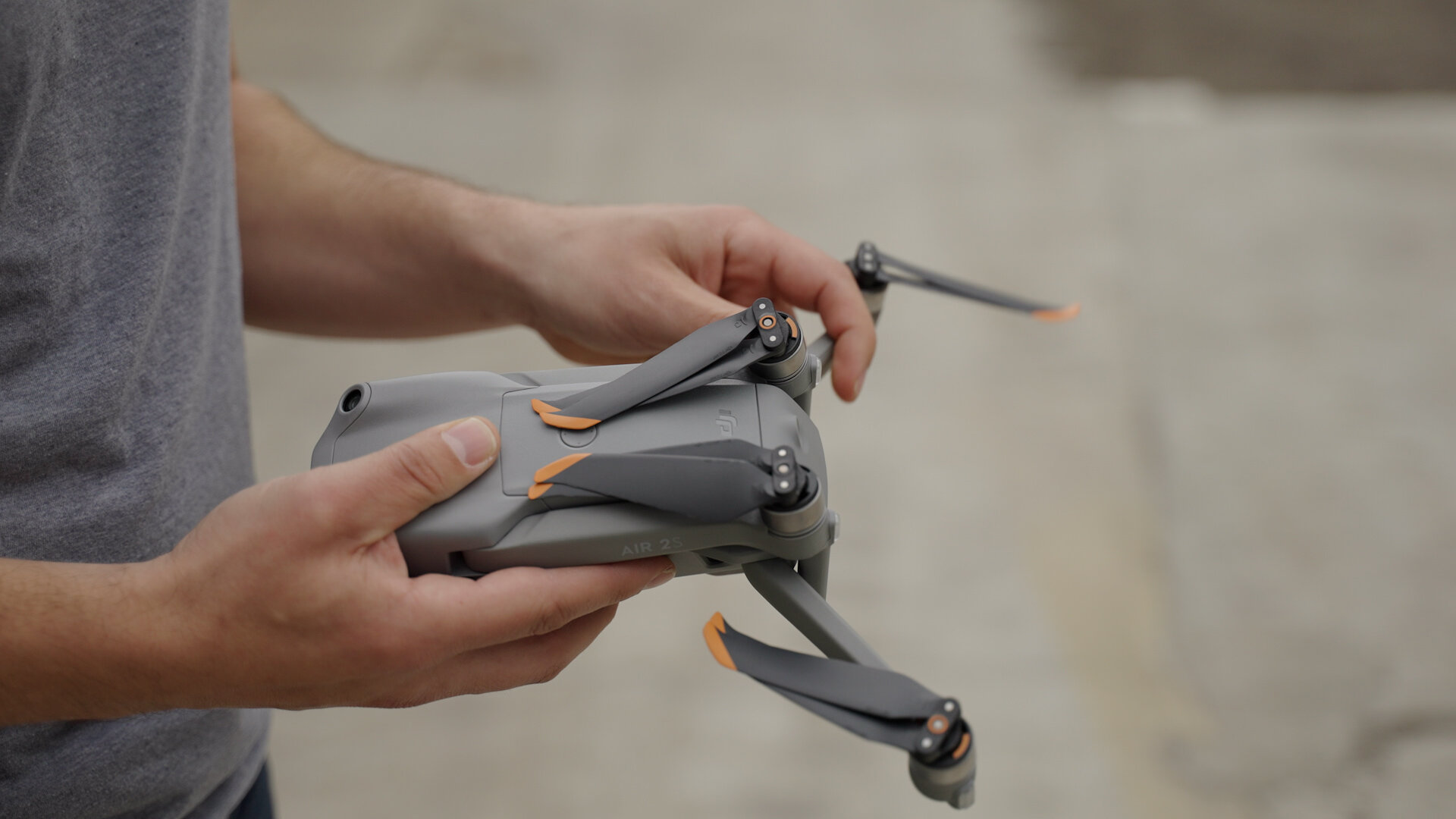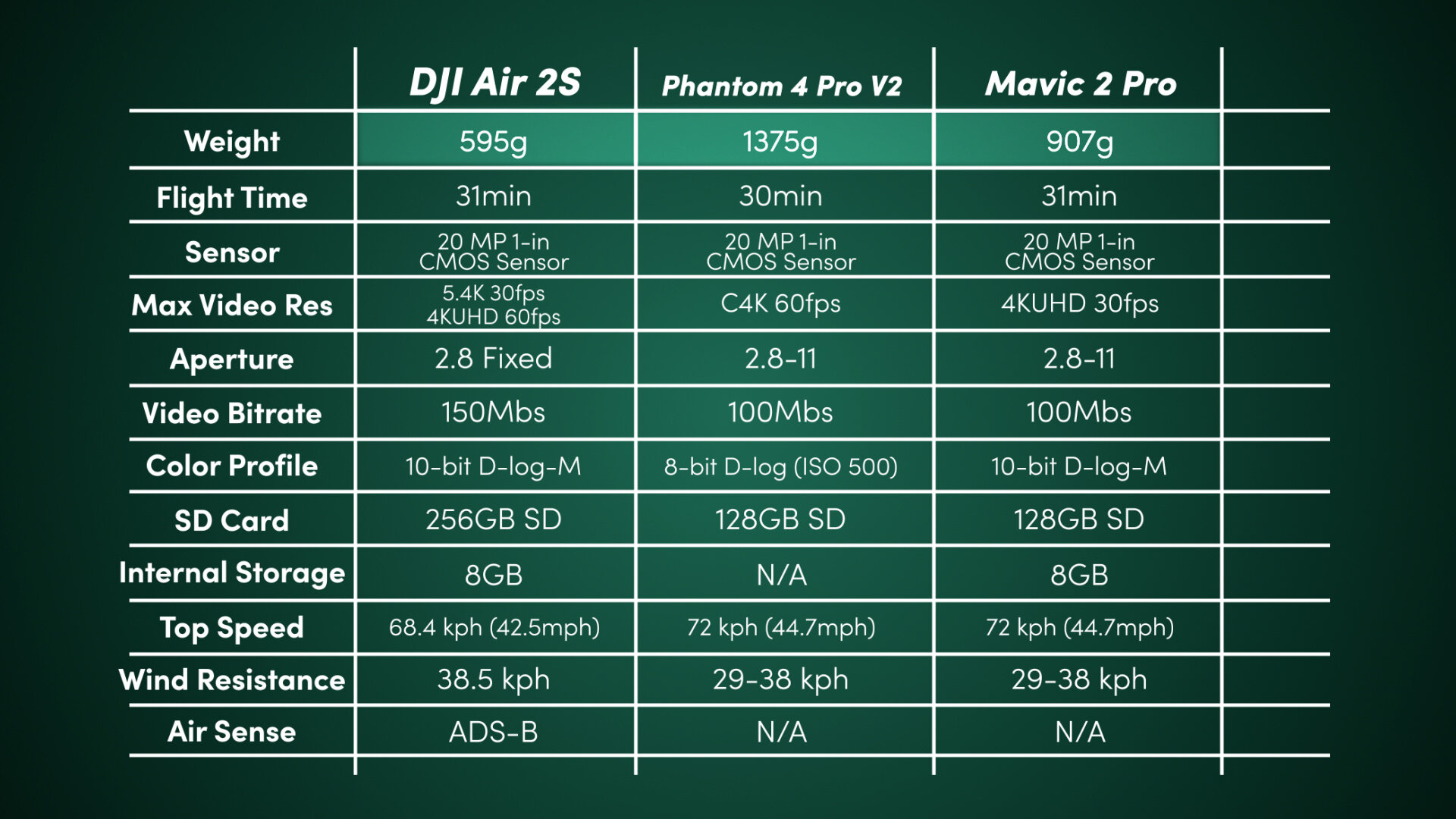DJI Air 2S - Best Drone for the Money?
Aerial shots are one of the most effective ways to set the scene in a film, but achieving this view can be tricky. Drones are great tools for filming establishing shots as they provide a perspective one can only obtain from the air.
The DJI Phantom series is a great combination of pro level video features at an affordable price. While the DJI Inspire series offers interchangeable lenses and the ability to change the entire camera module, the Phantom 4 Pro 2 and the DJI Air2S are the best value proposition for obtaining high quality aerial shots.
Remember, it's not so much which is the best camera, but rather which camera is going to fit your personal workflow, make life easier, and still give professional results.
Though drone cameras like the Phantom and the Mavic Pro 2 have become very popular, there are two key reasons why The Air2S might be the best option overall.
Image Quality
When deciding on a camera, it’s important to note the quality of footage a drone obtains. The Air 2 drones have added some amazing imaging capabilities, with its headline feature as a 5.4k 30p capable video camera
Portability
As shown in the video, there is a substantial size difference between the Phantom and the Air 2S. The Phantom is a classic style that has not changed for the last five or so years. However, because the Phantom is bigger, the camera mounting position is further from the propellers, meaning it is less likely to have propellers in the footage when traveling at high speeds.
Compared to the Phantom, the Air Series is both smaller and completely collapsible, with a more modern and sleek design. It's much more compact, meaning it’s easier to transport the camera through a variety of terrains and filming locations.
Now it’s time to get into the nitty gritty and look at each drone’s specifications. As shown in the video, the chart is comparing the DJI Air 2S with the Phantom 4 Pro and the Mavic 2 Pro for reference.
The weight of the DJI Air 2S comes in at 595 grams compared with 1,375 grams for the Phantom 4 Pro V2. For reference, the Mavic 2 Pro comes in at just over 900 grams.
When looking at flight times and sensors for each camera, they're pretty much the same across the board. The flight times only differ by one minute and each camera has a 20 MP 1 inch CMOS Sensor.
Where the difference occurs is in the readout from each sensor, specifically when it comes to video. The Air 2S is capable of recording in the full sensor readout of 5.4k at 30 frames per second. The Phantom 4 pro tops out at DCI 4k, at 60 frames per second, while the Mavic Pro 2 tops out at 4kUHD at 30 frames per second.
Another major difference between the cameras is that the Air 2S comes with a fixed aperture of F2.8, where the Phantom 4 Pro and the Mavic 2 Pro both come with a variable aperture that goes from F2.8 to F11. Though The fixed aperture might seem like a big con when wanting to change exposure while up in the air, in practice, aerial lighting conditions aren't going to change very much.
This means achieving a good exposure on the ground should ensure good exposure in the air. However, there is always the option to change the ISO while in the air, and the Air 2S has a very usable range, which gives enough flexibility to change exposure mid-flight.
The Air 2S technology also shoots at a higher video bitrate. The drone can still shoot in the h.265 HEVC codec that both the Phantom 4 Pro and the Mavic 2 Pro shoot in, but the Air 2S also shoots at 150 megabits per second. The other drones top out at 100 megabits per second.
Essentially, this feature gives the Air 2S more data per second when compared with the Phantom 4 Pro and the DJI Mavic Pro 2.
The Air 2S shoots in 10-bit D-log, where the Phantom 4 Pro is limited to an 8-bit codec. The Phantom can shoot in D-log, however, using the D-Cinelike color profile is generally a better option for the 8-bit codec.
The DJI Mavic Pro 2 can shoot in 10-bit log, just like the Air 2S. The 150 megabit per second codec allows for more information in post-production when trying to push the color grade a little further.
Another nice feature of the Air 2S and the Mavic Pro 2 is its 8 gigabytes of internal storage. This means accidentally showing up to a shoot without an SD card no longer means a lost opportunity for aerial footage. The 8 gigabytes offer enough space in a pinch.
The Air 2S also uses the brand new O-3 transmission signal, also known as Ocusync 3.0, where the other two cameras use the Ocusync 2.0. The upgraded transmission signal means a better signal from the remote controller to the drone itself.
The other bonus of the upgraded transmission technology in the Air 2S, as opposed to the other two drones, is the ability for live view at 1080p, 30 frames per second. Having that extra resolution in live view allows for better overall focus pull.
The top speed of the Phantom Pro 4 and the Mavic Pro 2 is 72 kilometers per hour, where the Air 2S is limited to 68.4 kilometers per hour. This is not a huge difference, but a slight disadvantage for the Air 2S.
One of the worries when moving from a bigger, bulkier drone to a smaller, lighter drone is whether or not the smaller camera will be impacted by high winds. However, the compact Air 2S is just as stable, if not more stable than the Phantom, even in inclimate weather scenarios.
The Air 2S can withstand winds of up to 38.5 kilometers per hour, where the other drones top out at 38 kilometer per hour. While this is very similar, it's surprising that the Air 2S holds its own, even though it is the lightest of the three designs.
Many drones are implementing sensing capabilities into their design. The Phantom 4 Pro has two sensors on the back, on each side, and on the bottom and front. Meanwhile, the Air 2S has forward-facing sensors and backward-facing sensors, as well as sensors on the bottom. With the new design, the Air 2S also has two additional upward facing sensors.
The Air 2S and the Mavic Pro 2 have an electronic shutter, where the Phantom 4 Pro has a mechanical shutter. This feature helps get rid of the “jello effect” or the appearance of wobbling buildings when the camera moves across a scene.
Another new feature of the Air 2S that will most likely become standard issue in future drone models is the ADS-B system or Automatic Dependent Surveillance–Broadcast system. The ADS-B system can intercept and interpret the ADS signals from aircrafts in the area and give a live positioning of any aircrafts flying nearby.
A big difference in camera designs is seen with the controllers. Each controller’s technology has its pros and cons, however, the design of the Air 2S is a bit more user-friendly than the Phantom 4 Pro.
The Phantom’s controller is a little cumbersome and the phone mounts tend to loosen over time. If shooting with a larger device, like an ipad, the mounting pad is unable to stay upright no matter how much it’s tightened.
The Air 2S controller is too small to mount larger devices, however phones mount perfectly without any loosening. The camera also has a built-in cable that plugs directly into the phone. Having this built-in cable means one less gadget to forget when packing up for a shoot.
After looking at major differences in design and capabilities between drones, the most important consideration is “value for dollar”- this is where the Air 2S shines. With the drone’s imaging capabilities, new transmission technology and ADS-B air sense, the Air 2S packs a ton of professional features into a small footprint.
When it comes to cost between the three drone options, the Air 2S price tag is much more approachable at $1000 for the base kit, where the Mavic 2 Pro and the Phantom 4 Pro are both $1600. As shown in the video, the Air 2S’s “value for dollar” increases when examining the “Fly More Package” kits for each camera.
One final pro of the Air 2S design is the compact design of both the camera and its carrying case. The case fits not only the camera, but also all of the “fly more package” assets, including extra batteries, battery hub, and ND filters- meaning an entire drone setup can literally hang off your shoulder.
Drones have become a must-have piece of technology for video production and choosing between the wide variety of camera options can feel daunting.
While each drone examined in this blog has its pros and cons, the question really becomes: “Will the Air 2S make life easier without losing quality or breaking the bank?” And the answer is a resounding: “Yes.”








